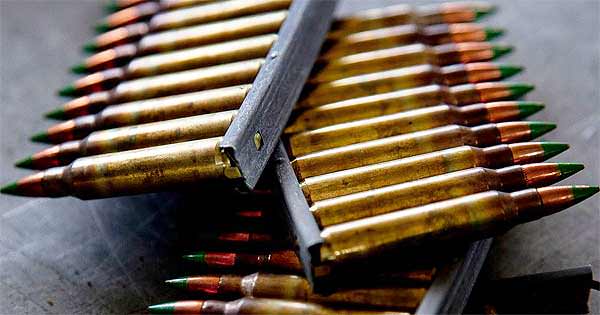F.A.I.R. Trade Group Will Vigorously Oppose ATF Efforts To Reclassify Rounds As “Armor Piercing Ammunition”


USA – -(Ammoland.com)- On February 13, 2015, the Bureau of Alcohol, Tobacco, Firearms and Explosives (ATF) released its proposed framework for determining whether a particular projectile may be exempted from the definition of “armor piercing ammunition.”
The complete text of the document, which we will refer to as simply “the framework,” can be accessed at ATF’s website here.
I. What is Armor Piercing Ammunition?
In 1986, Congress amended the Gun Control Act by adding certain provisions to restrict certain ammunition as “armor piercing ammunition,” making it (1) unlawful to manufacture and import armor piercing ammunition, and (2) prohibit licensed manufacturers and importers from selling or delivering armor piercing ammunition. The only exceptions to these prohibitions are for government agencies, exports, and for testing or experimentation authorized by the Attorney General.
The definition of “armor piercing ammunition” is extremely broad and captures many rifle rounds because it includes a projectile or projectile core which may be used in a handgun and which is constructed entirely from one or a combination of tungsten alloys, steel, iron, brass, bronze, beryllium copper or depleted uranium. The Attorney General has the authority to exempt from the definition any projectile which he finds is “primarily intended to be used for sporting purposes.” In 1986, ATF used this authority to exempt 5.56 mm (.223) SS109 and M855 “green tip” ammunition containing a steel core. In 1992 ATF used the sporting purposes exemption again for .30-06M2AP cartridges.
Since 2011, ATF has received more than 30 exemption requests for various ammunition containing steel or other specified metal cores. The reasons for the increased number of requests include pressure on the ammunition industry to produce alternatives to lead ammunition, as well as increased production of handguns designed to use conventional rifle ammunition (for example, the so-called AR15 pistols or AK pistols). Even though the ammunition was originally produced for rifles, the fact the rounds can be used in a handgun brings the ammunition within the statutory definition. Consequently, ammunition manufacturers have requested exemptions so they may lawfully manufacture and distribute the ammunition in commercial channels.
II. F.A.I.R. Warned of Potential Problems with an ATF-Designed Framework for Sporting Purposes
F.A.I.R. is the industry expert on ATF’s use of “sporting purposes” to restrict importation of popular firearms and barrels. Our members have lived through some of the most painful federal encroachment on commerce due to dramatic changes of the administration’s interpretation of the law, and so we were very skeptical when, in November 2012, ATF announced it would meet with law enforcement, non-profit groups, ammunition manufacturers and industry trade groups to discuss the sporting purposes exemption to the AP Ammo definition. F.A.I.R. attended this meeting and expressed its concern over ATF’s historically restrictive approach to “sporting purposes” and the fact that establishing specific criteria for the AP Ammo exemption, when ATF is not required to establish specific criteria, will no doubt limit “sporting purposes” yet again. See F.A.I.R. Trade Group Recent Actions under Dec. 7, 2012 and Jan. 31, 2013.
Unfortunately, ATF has proven F.A.I.R. justified in its skepticism and has once again adopted a very restrictive view of what constitutes sporting purposes.
III. Summary of ATF’s Proposed Framework
The framework emphasizes the importance of interpreting the statute in a manner that carries out ATF’s goal of protecting law enforcement officers from death or injury from criminal use of handgun ammunition capable of penetrating soft body armor. Against this background, ATF states it must determine that a specific projectile does not pose a significant threat to law enforcement officers because the projectile is “primarily intended” for use in shooting sports and is unlikely to be encountered by law enforcement officers on the streets.
In interpreting the “primarily intended” language, ATF believes the most relevant intent is that of a criminal who seeks to use armor piercing ammunition. ATF notes that the manufacturer’s intent that the ammunition be used for hunting or target shooting is irrelevant if it can potentially be diverted to criminals to defeat soft body armor worn by police officers. For this reason ATF rejects adopting an interpretation that allows the manufacturer’s intent to be dispositive, but that it is appropriate to consider the likely use of a particular type of ammunition in the general community, which leads to consideration of the types of handguns readily available to accept that ammunition. In other words, the characteristics of the handguns in which a specific projectile may be used will determine that projectile’s likely use in the community.
The framework sets forth two categories of projectiles which would be eligible for exemption under the “primarily intended to be used for sporting purposes” language. Those projectiles are the following:
1. Category I: .22 Caliber Projectiles
A .22 caliber projectile that otherwise would be classified as armor piercing ammunition under 18 U.S.C. 921(a)(17)(B) will be considered to be “primarily intended to be used for sporting purposes” under section 921(a)(17)(C) if the projectile weighs 40 grains or less AND is loaded into a rimfire cartridge.
2. Category II: All Other Caliber Projectiles
Except as provided in Category I (.22 caliber rimfire), projectiles that otherwise would be classified as armor piercing ammunition will be presumed to be “primarily intended to be used for sporting purposes” under section 921(a)(17)(C) if the projectile is loaded into a cartridge for which the only handgun that is readily available in the ordinary channels of commercial trade is a single shot handgun. ATF retains the discretion to deny any application for a “sporting purposes” exemption if substantial evidence exists that the ammunition is not primarily intended for such purposes.
The term “single shot handgun” means a break-open or bolt action handgun that can accept only a single cartridge manually, and does not accept or use a magazine or other ammunition feeding device. The term does not include a pocket pistol or derringer-type firearm.
IV. Impact of Framework – Previous Exemptions
A critical consequence in ATF applying the sporting purposes categories set forth above will be a revocation of the exemption ATF originally granted the 5.56mm projectile in 1986. The round, primarily sourced outside the U.S. and very popular among shooting sports enthusiasts, will NOT qualify for an exemption because cartridges containing this projectile may be used in handguns that are not single-shot. These cartridges are commonly used in AR-type handguns that utilize magazines. Accordingly, for purposes of consistency, ATF states that it will withdraw the exemptions for the 5.56mm “green tip” ammunition, including both the SS109 and M85 cartridges.
Conversely, the exemption for the 30-06 M2AP cartridges would continue because there are no multi-shot handguns that currently accept such ammunition.
Until ATF implements the proposals outlined in the February 13, 2015, framework, the 5.56mm “green tip” ammunition will continue to be exempt from the controls applicable to “armor piercing ammunition.” Accordingly, it is our understanding that manufacturers and importers with existing inventories of this ammunition may continue to distribute it in the same manner as any other ammunition. As far as imports with existing permits, F.A.I.R. is not aware of ATF suspending import permits authorizing the importation of 5.56mm ammunition into the U.S., so we understand that importers with approved permits may continue to use them to import “green tip” ammunition and distribute it in the U.S. until ATF withdraws the exemption. However, industry must remember that once the exemption is withdrawn, the ammunition may be lawfully distributed ONLY to Federal, State, or local government agencies or for purposes of testing or experimentation authorized by ATF.
It is clear from ATF’s proposed framework that the agency will likely rescind the 1986 exemption for 5.56mm “green tip” ammunition within the near future. What remains to be seen is whether the agency will grant some sort of “grace period” that will allow importers and manufacturers to distribute existing stocks of 5.56mm ammunition free of the restrictions that apply to armor piercing ammunition. It is also unclear whether ATF would be willing to allow importers with approved permits authorizing the importation of 5.56mm ammunition to continue to import and distribute such ammunition for a specified period. ATF has the authority to refrain from taking enforcement action for provisions of the laws under its jurisdiction. Because the exemption for 5.56mm ammunition has been in place for many years and has been relied upon by members of the firearms industry, F.A.I.R. will propose that ATF should phase in its withdrawal of the exemption. Such a move is not unprecedented, as the agency took such a position in 2010 regarding certain explosives, allowing a 6-month grace period for persons to receive and possess explosives pest control devices without complying with the Federal explosives laws.
The Open Letter relating to this policy can be found on ATF’s website at https://www.atf.gov/press/releases/2010/11/111210-openletter-fel-use-of-epcds.html.
V. Impact of Framework on Pending Exemption Requests

A significant number of cartridges originally manufactured for rifles would not be eligible for the exemption under the criteria proposed in the framework. For example, .224 and .308 cartridges would not be exempted due to the availability in commercial channels of AR and AK-type pistols, clearly not single-shot firearms. Projectiles in .430 caliber would also not be exempted due to the availability of .44 magnum handguns which will chamber this ammunition. Finally, .458 bullets, very popular for big game hunting, would not be exempted due to the availability of multi-shot handguns in 45-70 caliber. All of this ammunition would continue to be subject to the restrictions on manufacture, importation, and distribution of armor piercing ammunition.
VI. Public Comment
ATF is soliciting comments on the proposed framework from all interested parties. As noted above, ATF specifically requests comments on how best to implement the withdrawal of the exemption for 5.56 mm ammunition to minimize disruption to the industry.
All comments must be received by ATF on or before March 16, 2015. Comments may be submitted through ATF’s website at APAComments@atf.gov. Comments may also be faxed to (202)648-9741 or mailed to the following address:
Denise Brown
Mailstop 6N-02
Office of Regulatory Affairs
Enforcement Programs and Services
ATF
99 New York Avenue, NE
Washington, DC 20226
ATTN: AP Ammo Comments
F.A.I.R. will prepare a comment on ATF’s proposed framework opposing the reclassification of 5.56 green tip ammunition that will include (1) a suggested alternative to the sporting purposes test; and (2) a recommendation for a reasonable grace period for phasing in the new policy on 5.56mm ammunition. F.A.I.R. also will address the use of import permits for the ammunition issued prior to February 13, 2015.
However, even though F.A.I.R. will be submitting a comment, members are strongly encouraged to submit individual comment on the proposals. The more comments that are submitted, the stronger the message to ATF.
The F.A.I.R. Trade Group is a 501(c) (6) organization dedicated since 1994 to protecting the interests of the firearms and ammunition import and export community. F.A.I.R. operates entirely on the funds derived from our dues-paying membership. If you are interested in becoming a member or contributing to the organization, please visit our website at: www.fairtradegroup.org.
Our mailing address is:
Fair Trade Group
1425 K Street, NW
Suite 350
Washington, DC 20005
